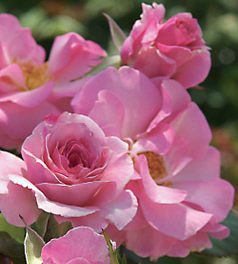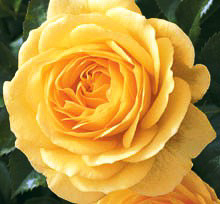Four-Season Tips for Your Rose Garden by Marci Martin, Consulting Rosarian
Marci does fall pruning
Early Spring:
April is the time to begin removing winter protection. Rose cones can be removed, or level out the mulch or soil you used to cover the plants. This is also a good time to have a soil test done, before you add fertilizer to the soil. Woodland Gardens carries UConn soil test kits, which will offer a soil analysis and recommendations for adjusting your soil for your own particular needs.
Spring pruning encourages roses to grow. A good indicator for pruning in your area is blooming forsythia. Once you see these cheery yellow flowers in your neighborhood, it's time to start pruning. Use bypass pruners, and trim at a 45-degree angle to an outward-facing bud. Trim any canes crossing over each other, as their prickles can cause a lot of damage. Try to open up the center of the rosebush to increase air circulation. And seal your canes with Elmer's Glue to keep the borers out.
Summer:
By now, you have planted your bare root roses, and they are up and flourishing. Potted roses can be added to the rose garden at any time during the growing season.
The most important element in rose care during the summer is WATER. Roses are thirsty plants and need three to five gallons of water apiece per week. Every spring, I take my watering wand and a five-gallon bucket and count how many seconds my tap takes to deliver five gallons of water. Then I water my roses accordingly, usually twice a week. Each rose in my yard is watered individually for 30 seconds. (With my water pressure, 30 seconds equals three gallons.) The idea behind watering roses deeply is that we want to establish a good, deep root system so the plants can withstand possible drought. And remember to water the soil, not the leaves.
You should also be sure to FEED your roses, as they are vigorous growers and can deplete the soil. I like to use Bayer Advanced Garden Rose and Flower Care, because it works systemically for six weeks, releasing plant food and insecticide each time you water, for six weeks. This is a great product for ridding your plants of sucking insects such as aphids and mealy bugs.
In order to keep that beautiful foliage healthy, it's a wise idea to spray your roses with a FUNGICIDE every seven to ten days. This product is most easily delivered with a pump-up sprayer set on a fine mist mode, so that it's easy to fog the plant. Spray the bottoms and tops of your leaves just to the point of run-off. The best time to spray is early morning or early evening when the air is cool and still. Be sure to water before spraying so the plants are turgid.
For caterpillars, Japanese beetles, and other chewing insects, you'll need to add some insecticide to your spray material. Bayer, Ortho, and Sprectracide all make great products that are absorbed by the plant in about an hour and protect against insects and disease for a 7-to-10-day period.
Meanwhile, cut your lovely blossoms on stems as long as you like, to a five-leaf petiole on the outward side of the stem. Your new cane will sprout from that spot and will grow outward to keep the center of the bush more open and improve air circulation.
PS: When using chemicals, be sure to read all labels. Wear rubber gloves, and try to spray when the air is still. If a breeze arises, try to keep it at your back, and take a shower when you're finished.
Fall & Winter:
As of late October, it is time to sit back and enjoy your beautiful fall blooms. You will find that autumn roses last a long time in a vase, have stronger fragrances, and are richly colored. This is because they take longer to develop and are loaded with sugar.
Try not to cut all your roses, however. My grandsons and I love this time of year because they are allowed to pull off the petals and scatter them to the wind like giant confetti. The purpose behind this is that if the roses are allowed to produce a few "hips" (seed pockets), they start producing a winter hormone that pulls the sap deep within the canes to toughen them for the winter to come.
I generally stop spraying this time of year, but I continue to water deeply so my roses will go into their dormancy well hydrated.
Now is NOT the time to prune your roses back, because we don't want to stimulate a lot of new growth at this time of year. Instead, that energy should stay within the plant to stimulate growth next spring.
After Thanksgiving, cut your bush roses (hybrid teas, grandifloras, floribundas, and minis) to about 18-24 inches. (I call this "gross pruning," because there's nothing fancy about it. We will "fine prune" in the spring when growth commences.)
After pruning, bury your bush roses with shredded pine bark mulch, forming a mound over the plant. In extremely cold and windy areas, it's a good idea to cover the rose with a styrofoam rose cone. Just pop it on, put a big rock or brick on the top, and your rose is winterized. Rose cones are not for sheltered areas, however, because the sunlight can cause excessive heat inside the cone. Remember that we winterize our roses to keep them cold so they don't break dormancy during winter thaws. Remember also, yellow roses have a tendency to be more winter tender than others. Make sure you cover them well.
Shrub roses need to be cut back a bit so their canes don't act like a sail in winter gales. First-year shrubs should be mounded with mulch, but in ensuing years should get by just fine with no protection. Same story for first-year climbers. Mound them up, and tie up any unruly canes. Do not prune climbers in the fall. Wrap the canes of first-year climbers with burlap for protection. After the first year, protection may not be necessary.
When you're finished winterizing, say "good night," wash your hands, and enjoy your holidays. Now you'll have all winter to sharpen your tools, read rose catalogs, and dream about spring



